Homepage > Documents > Harenkarstival Project
Music and theatre project with compositions by Frans Absil
"Harenkarstival": An overview of the Harenkarspel 2008 Music and Theatre Project
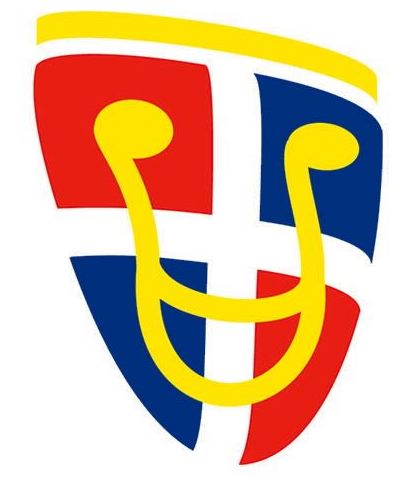 This page contains an overview of the Harenkarstival 2008 Music and Theatre Project, staged 5-8 June 2008 in Warmenhuizen (Harenkarspel, North Holland). I was involved in this project as production management team member and music composer.
This page contains an overview of the Harenkarstival 2008 Music and Theatre Project, staged 5-8 June 2008 in Warmenhuizen (Harenkarspel, North Holland). I was involved in this project as production management team member and music composer.
The Harenkarstival Project received an award in the 11th Edition of "Kern met Pit", a Netherlands national contest with a jury evaluating local social and cultural initiatives.
Project description >> | Composing >> | The event >> | Participants >> | Program and full scores >>
Project description
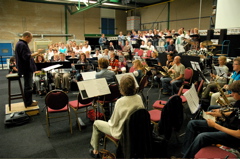
The Harenkarstival Project is a music and theatre festival that took place in 2008 in Harenkarspel, North Holland. Various art forms, i.e., music, theatre, dance and film, were combined in an impressive show with original music. A set of production numbers depicted local historical, industrial, social and cultural themes. After almost two years of preparation, more than hundred performers participated in a series of concerts on a large stage, supported by complex sound, lighting, and film projection equipment. The project involved considerable logistics and many volunteers from the local community.
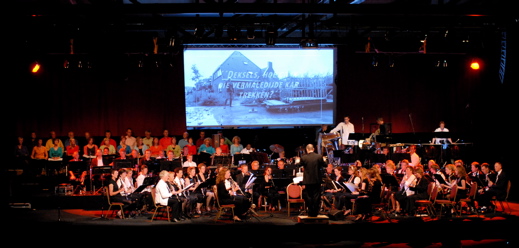 The first brainstorm sessions took place in mid 2005. In 2006 a project management team was formed and the commitment of a number of local music groups and theatre companies was secured. The musical supervision was in the hands of conductor Ton van de Kieft. With the support by Ger Beemsterboer, CEO of Bejo Zaden in Warmenhuizen, the go-ahead decision was taken in the second half of 2006.
The first brainstorm sessions took place in mid 2005. In 2006 a project management team was formed and the commitment of a number of local music groups and theatre companies was secured. The musical supervision was in the hands of conductor Ton van de Kieft. With the support by Ger Beemsterboer, CEO of Bejo Zaden in Warmenhuizen, the go-ahead decision was taken in the second half of 2006.
Project description >> | Composing >> | The event >> | Participants >> | Program and full scores >> | Top of page >>
Composing the music
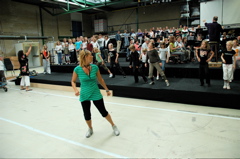 As a framework, I proposed the full program for the event. In 2007,
the music was written at a pace of roughly one piece per month. The instrumentation involves various combinations of symphonic wind band, soloists, chamber choir, children's choir, pop group, street organ and sound effects. A number of professional musicians (Netherlands Philharmonic Orchestra, Metropole Orkest, free-lance) were hired for the rhythm section and lead chairs in the orchestra.
As a framework, I proposed the full program for the event. In 2007,
the music was written at a pace of roughly one piece per month. The instrumentation involves various combinations of symphonic wind band, soloists, chamber choir, children's choir, pop group, street organ and sound effects. A number of professional musicians (Netherlands Philharmonic Orchestra, Metropole Orkest, free-lance) were hired for the rhythm section and lead chairs in the orchestra.
 The production required a mix of styles: a number of short symphonic poems depicted historical aspects (fighting the sea, war and conflict). Popular music expressed social and cultural themes: a Latin medley, rhythm & blues, folk and rock. Some pieces required a challenging, rather complex layering, staging and carefully timed performance. E.g., the musical-style depicting of the village fair combined orchestra, chamber and children's choir, street organ and sound effects. A chorale theme with variations was written for the five church organs, each variation respecting the specific organ sound and village church acoustics. The variations were recorded separately, than juxtaposed in an audio track. This was played over the PA system, combined with screen projection of video footage and on-stage introduction and coda by the chamber choir. After shooting the ironic black-and-white mockumentary about the local society in mid 2007, appropriate film music was written that was later performed live with the movie.
The production required a mix of styles: a number of short symphonic poems depicted historical aspects (fighting the sea, war and conflict). Popular music expressed social and cultural themes: a Latin medley, rhythm & blues, folk and rock. Some pieces required a challenging, rather complex layering, staging and carefully timed performance. E.g., the musical-style depicting of the village fair combined orchestra, chamber and children's choir, street organ and sound effects. A chorale theme with variations was written for the five church organs, each variation respecting the specific organ sound and village church acoustics. The variations were recorded separately, than juxtaposed in an audio track. This was played over the PA system, combined with screen projection of video footage and on-stage introduction and coda by the chamber choir. After shooting the ironic black-and-white mockumentary about the local society in mid 2007, appropriate film music was written that was later performed live with the movie.
 A Weblog informed participants about the progress of the compositions. Instrumental parts were extracted from the scores during the second half of 2007. The sheet music (scores and parts) was distributed to all participants as PDF files on CD ROM, with MIDI to audio mixdowns to familiarize the participants with the musical idiom and speed up the rehearsal process.
A Weblog informed participants about the progress of the compositions. Instrumental parts were extracted from the scores during the second half of 2007. The sheet music (scores and parts) was distributed to all participants as PDF files on CD ROM, with MIDI to audio mixdowns to familiarize the participants with the musical idiom and speed up the rehearsal process.
Project description >> | Composing >> | The event >> | Participants >> | Program and full scores >> | Top of page >>
The event
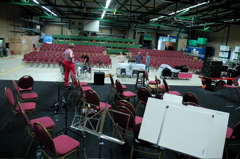 In 2008 the rehearsals started, in parallel with a publicity campaign. Instrumental groups got together to study their parts. A project logo was designed, and a Website and social network group were created. The theatre company rehearsed a set of scenes that were used as transitions between the music numbers.
In 2008 the rehearsals started, in parallel with a publicity campaign. Instrumental groups got together to study their parts. A project logo was designed, and a Website and social network group were created. The theatre company rehearsed a set of scenes that were used as transitions between the music numbers.
Local newspapers (Noord-Hollands Dagblad, Schagen and Alkmaar edition) and music magazines (KNFM Muziek & Show) reported about the event. Publicity flyers and a special tabloid format newspaper were distributed in the weeks up to the event. Festival posters appeared in shop windows and large roadside banners were raised.
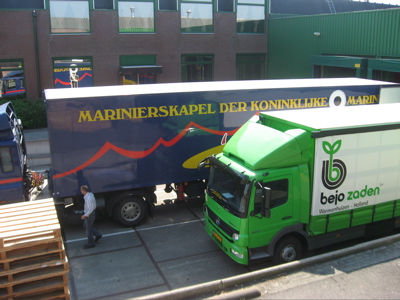 In May 2008, the 'Bejo Concert Hall' was created, working from design drawings and according to a strict schedule; a large production and storage hall now contained a 16 by 12 m stage and 500 seats. Lighting equipment and a 4 by 6 m film projection screen, kindly made available by Sharp Nederland, were installed. Henk Tjoonk from Tjoonk Geluidsprodukties brought two assistents and a truckload of PA sound equipment, including two mixing consoles (90 channels in total) and 19-inch racks with sound processing units. First aid and fire emergency measures were implemented, catering facilities put in place.
In May 2008, the 'Bejo Concert Hall' was created, working from design drawings and according to a strict schedule; a large production and storage hall now contained a 16 by 12 m stage and 500 seats. Lighting equipment and a 4 by 6 m film projection screen, kindly made available by Sharp Nederland, were installed. Henk Tjoonk from Tjoonk Geluidsprodukties brought two assistents and a truckload of PA sound equipment, including two mixing consoles (90 channels in total) and 19-inch racks with sound processing units. First aid and fire emergency measures were implemented, catering facilities put in place.
Local and national radio did announcements and interviews: conductor Ton van de Kieft appeared on Schagen FM and Radio Langedijk, I was interviewed by Franck du Mosch on Radio 2 in NCRV Cappuccino and North Holland radio sent their reporter Bart Breukel from RTV-NH Op Locatie.
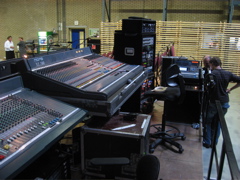 Three concerts took place on 5, 6 and 7 June 2008. The impressive Harenkarstival show was received well. Everybody was more than satisfied with the performance; perfect timing, no system malfunctions, no accidents. Video recording was done to create a live DVD, unfortunately with poor sound quality. The closing concert on Sunday 8 June 2008 was played by the Marine Band of the Royal Netherlands Navy, conducted by Dik Roelofsen and Sander van de Loo. The Harenkarstival project received an award in the 11th Edition of "Kern met Pit", a Netherlands national contest for local social and cultural initiatives
Three concerts took place on 5, 6 and 7 June 2008. The impressive Harenkarstival show was received well. Everybody was more than satisfied with the performance; perfect timing, no system malfunctions, no accidents. Video recording was done to create a live DVD, unfortunately with poor sound quality. The closing concert on Sunday 8 June 2008 was played by the Marine Band of the Royal Netherlands Navy, conducted by Dik Roelofsen and Sander van de Loo. The Harenkarstival project received an award in the 11th Edition of "Kern met Pit", a Netherlands national contest for local social and cultural initiatives
Project description >> | Composing >> | The event >> | Participants >> | Program and full scores >> | Top of page >>
Participants
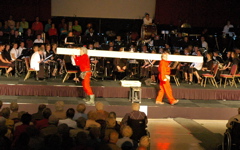 Project management team: Frans Absil, Ger Beemsterboer,
Hanny Blankendaal, Andries Dekker, Jan Dekker, Ton van de Kieft,
Piet Meijer, Natascha Paarlberg.
Music director and conductor: Ton van de Kieft.
Composer: Frans Absil.
Orchestra: Symphonic Wind Band Harmonie DSV, Warmenhuizen,
extended with musicians from the Netherlands Philharmonic Orchestra,
Metropole Orkest and a jazz rhythm section. Final concert by the Marine
Band of the Royal Netherlands Navy, conducted by Dik Roelofsen (classical part) and Sander van de Loo (show session).
Choir: Chamber Choir Sine Nomine, Alkmaar
(conductor: Paul Valk) and primary school children's choir
(leader: Chris Mul).
Pop Group: Splinter (lead vocals: Siem Broersen).
Soloists: Werner van de Loo (trumpet), Jan Kühne (soprano and tenor saxophone), Gerrit van Baarlen (baritone saxophone), Herman and Niels Quant (street-organ Adriana), Gertie (accordion), Dick Barten
(church organs).
Theatre company: Spot'70, Warmenhuizen (on stage, director: Aad Spee) and Ons Genoegen, Waarland (on film).
Dance: street dance 4AnyBody, Warmenhuizen (choreography:
Nancy Benschop).
Film director: Job van de Kieft.
PA and sound system: Henk Tjoonk Geluidprodukties.
Video recording and DVD production: Paul Tetteroo.
Stage design and construction team manager: Piet Meijer.
Lighting: Menno Hartenberg.
Bejo facility crew leader: Guus Leegwater.
Publicity: Hanny Blankendaal, Erica Broers, Trudie de Groot.
Logo and graphic design: Job van de Kieft.
Photographer: Nico Komen.
Webdesign: Dennis Koper (Joomberg).
Production coordinator: Dixie Hartenberg.
Project support, finance and administration: Natascha Paarlberg, Pierre Fenijn.
Catering: Ulteam.
Logistic and facility support coordination: Andries Dekker, Ingrid Kramer.
Main sponsor: Ger Beemsterboer (CEO Bejo Zaden, Warmenhuizen).
Project management team: Frans Absil, Ger Beemsterboer,
Hanny Blankendaal, Andries Dekker, Jan Dekker, Ton van de Kieft,
Piet Meijer, Natascha Paarlberg.
Music director and conductor: Ton van de Kieft.
Composer: Frans Absil.
Orchestra: Symphonic Wind Band Harmonie DSV, Warmenhuizen,
extended with musicians from the Netherlands Philharmonic Orchestra,
Metropole Orkest and a jazz rhythm section. Final concert by the Marine
Band of the Royal Netherlands Navy, conducted by Dik Roelofsen (classical part) and Sander van de Loo (show session).
Choir: Chamber Choir Sine Nomine, Alkmaar
(conductor: Paul Valk) and primary school children's choir
(leader: Chris Mul).
Pop Group: Splinter (lead vocals: Siem Broersen).
Soloists: Werner van de Loo (trumpet), Jan Kühne (soprano and tenor saxophone), Gerrit van Baarlen (baritone saxophone), Herman and Niels Quant (street-organ Adriana), Gertie (accordion), Dick Barten
(church organs).
Theatre company: Spot'70, Warmenhuizen (on stage, director: Aad Spee) and Ons Genoegen, Waarland (on film).
Dance: street dance 4AnyBody, Warmenhuizen (choreography:
Nancy Benschop).
Film director: Job van de Kieft.
PA and sound system: Henk Tjoonk Geluidprodukties.
Video recording and DVD production: Paul Tetteroo.
Stage design and construction team manager: Piet Meijer.
Lighting: Menno Hartenberg.
Bejo facility crew leader: Guus Leegwater.
Publicity: Hanny Blankendaal, Erica Broers, Trudie de Groot.
Logo and graphic design: Job van de Kieft.
Photographer: Nico Komen.
Webdesign: Dennis Koper (Joomberg).
Production coordinator: Dixie Hartenberg.
Project support, finance and administration: Natascha Paarlberg, Pierre Fenijn.
Catering: Ulteam.
Logistic and facility support coordination: Andries Dekker, Ingrid Kramer.
Main sponsor: Ger Beemsterboer (CEO Bejo Zaden, Warmenhuizen).

Project description >> | Composing >> | The event >> | Participants >> | Program and full scores >> | Top of page >>
Program and music scores
Harenkarstival 2008 program details and music scores are given below.
1. De Strijd tegen het Water
Title: Overture De Strijd tegen het Water (Fighting the Sea)
Dur (min): 8
Time (hr:min): 0:00
Description: Symphonic poem, depicting nature in the low lands near the sea and man's effort to fight the water (storms and flooding), building dikes and polders. Instrumentation for orchestra, choir and sound effects.
Media:
MP3 Audio |
PDF Score (3.1 Mb)
2. Theatre Scene 1
Dur (min): 3 Time (hr:min): 0:08
3. Werken op het Land
Title: Song Werken op het Land (The Farm Worker's Song)
Dur (min): 4
Time (hr:min): 0:11
Description: Song, describing the struggle of the early farmers, trying to make a living of the land and fighting their lords. Musically, there is a gradual transition from a medieval style and mood, towards a more contemporary setting.
Media:
PDF Score (1.6 Mb) |
Song lyrics (in Dutch)
4. Theatre Scene 2
Dur (min): 3 Time (hr:min): 0:15
5. Oorlog in de Polder
Title: Instrumental Oorlog in de Polder (War in the Low Lands)
Dur (min): 7
Time (hr:min): 0:18
Description: This symphonic piece depicts the wars fought over the last centuries against intruders. A number of anthems and traditionals represent the parties involved. After winning the battle there is a hymn to liberty.
Media:
MP3 Audio |
PDF Score (2.1 Mb)
6. Theatre Scene 3
Dur (min): 3 Time (hr:min): 0:25
7. Ter Kerke Gaan
Title: Chorale Ter Kerke Gaan (Going to Church)
Dur (min): 4
Time (hr:min): 0:28
Description: Religion. Chorale theme with variations for church organ and mixed choir. Five church organs from the Harenkarspel community are featured (in a crossfade audio mix), with an introduction and coda with mixed choir.
Media:
MP3 Audio |
PDF Score (392 kb) |
Song lyrics (in Dutch)
8. Theatre Scene 4
Dur (min): 3 Time (hr:min): 0:32
9. Radio Rumba
Title: Instrumental Radio Rumba
Dur (min): 6
Time (hr:min): 0:35
Description: The 1950s. A compilation of cheerful and moody Latin pieces, for 3 soloists (trumpet, tenor and baritone saxophone) and orchestra. Essential parts for rhyhtm and percussion section.
Media:
MP3 Audio |
PDF Score (2.1 Mb)
10. Theatre Scene 5
Dur (min): 3 Time (hr:min): 0:41
11. Meer Haren dan Kapsel
Title: Song Meer Haren dan Kapsel (More Hair than Coiffure)
Dur (min): 4
Time (hr:min): 0:44
Description: The 1960s. Flower power, preaching cultural revolution, world peace and hippie age. Protest song for two singers, acoustic guitars with choral support.
12. Theatre Scene 6
Dur (min): 3 Time (hr:min): 0:48
13. De dorpskermis
Title: Song De dorpskermis (Village Fair)
Dur (min): 5
Time (hr:min): 0:51.
Description: Local culture. A cheerful song in musical style for children's choir and mixed choir, intertwined with mixed layers of village fair waltzes and polkas.
Media:
PDF Score (2.1 Mb) |
Song lyrics (in Dutch)
14. Harenkarspel in Taferelen
Title: Film Harenkarspel in Taferelen (Harenkarspel in Scenes)
Dur (min): 11
Time (hr:min): 0:56
Description: Landscape and local culture, depicted in a short black and white, soundless movie (quasi-ancient). Live film music. It has various moods (serious, hilarious, dance, thrill) to comment the film scenes.
Media:
YouTube movie
 |
PDF Score (3.7 Mb)
|
PDF Score (3.7 Mb)
15. Werken in de Bouw
Title: Song Werken in de Bouw (The Builder's Song)
Dur (min): 4
Time (hr:min): 1:07
Description: A swinging organ blues with a groove, in praise of the achievements of the building companies in the area. Mainly in big band setting with solo vocals, choral riffs and an ad lib solo for tenor saxophone.
Media:
PDF Score (804 kb) |
Song lyrics (in Dutch)
16. Identiteit
Title: Finale: Identiteit (Identity)
Dur (min): 8
Time (hr:min): 1:11
Description: Singers and choir comment on the identity and characteristics of the local community, accompanied by the orchestra. Opera-style setting with popular song (moderate 16th rock) closing.
Media:
YouTube movie
 |
PDF Score (2.6 Mb) |
Song lyrics (in Dutch)
|
PDF Score (2.6 Mb) |
Song lyrics (in Dutch)
